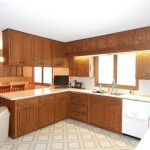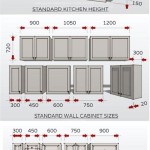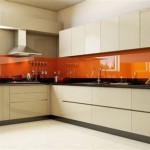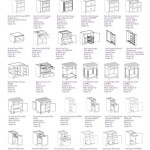Farmhouse Kitchen Cabinets: A Guide to Rustic Charm and Modern Functionality
Farmhouse kitchen cabinets represent a popular design choice for homeowners seeking a blend of rustic aesthetics and modern functionality. This style draws inspiration from traditional farmhouses, emphasizing natural materials, simple lines, and a warm, inviting atmosphere. Farmhouse cabinets are not merely storage solutions; they are integral components in creating a welcoming and functional kitchen space. They often feature elements that evoke a sense of history and craftsmanship, while still accommodating the demands of contemporary living.
The inherent charm of farmhouse cabinets lies in their ability to create a kitchen that feels both lived-in and stylish. They can be adapted to suit various kitchen layouts and sizes, making them a versatile option for both small apartments and large family homes. The selection process involves considering various factors, including material, style, finish, hardware, and overall kitchen design. Understanding these elements is crucial for achieving the desired farmhouse aesthetic and ensuring the longevity and functionality of the cabinets.
Key Elements of Farmhouse Kitchen Cabinets
Several defining characteristics distinguish farmhouse kitchen cabinets from other styles. These include the use of natural materials, a focus on simplicity, and the incorporation of specific design features that contribute to the overall rustic aesthetic. The following key elements are crucial for achieving a genuine farmhouse look.
Material Selection: The choice of material is paramount in achieving the desired farmhouse aesthetic. Wood is the primary material employed, with options ranging from solid wood species like maple, oak, and cherry to more budget-friendly alternatives such as wood veneers and painted MDF (Medium-Density Fiberboard). Solid wood offers durability and a timeless appeal, showcasing the natural grain patterns and imperfections that contribute to the rustic charm. Oak, in particular, is a popular choice due to its prominent grain and inherent strength. Maple provides a smoother surface for painting, while cherry offers a richer, darker tone.
Wood veneers offer a cost-effective alternative to solid wood, providing the appearance of natural wood at a lower price point. MDF, when properly sealed and painted, can be a durable and moisture-resistant option, particularly suitable for painted cabinets. The selection of material should be based on a balance of budget, desired aesthetic, and functional requirements.
Style and Design: Farmhouse kitchen cabinets typically feature simple, clean lines with minimal ornamentation. Shaker-style cabinets, characterized by a recessed panel in the center of the door frame, are a common choice. This style embodies the understated elegance and practicality associated with farmhouse design. Other style options include raised-panel cabinets, beadboard detailing, and glass-front cabinets, which allow for the display of dishware and decorative items.
Open shelving is another hallmark of farmhouse kitchens, providing accessible storage and opportunities to display decorative elements. Open shelves can break up long runs of cabinets and add visual interest to the space. Integrated islands are frequently incorporated into farmhouse kitchen designs, providing additional workspace and storage. These islands often feature details such as turned legs, butcher block countertops, and apron-front sinks, further enhancing the farmhouse aesthetic.
Finish and Color Palette: The finish applied to farmhouse kitchen cabinets plays a significant role in defining their overall appearance. Painted finishes are commonly used, with white, cream, and gray being popular choices. These light, neutral colors create a bright and airy feel, reflecting the natural light and contributing to the overall sense of warmth and comfort. Distressed finishes, which involve intentionally creating imperfections and wear marks, can add a sense of age and authenticity to the cabinets.
Stained finishes, which highlight the natural grain of the wood, are also suitable for farmhouse kitchens. Lighter stains, such as honey oak or natural maple, can create a warm and inviting atmosphere, while darker stains, such as walnut or cherry, can add a touch of sophistication. The choice of finish should complement the overall color scheme of the kitchen and reflect the desired level of formality.
Hardware Considerations for Farmhouse Style
Hardware selection is a crucial detail that can significantly impact the overall farmhouse aesthetic of kitchen cabinets. The hardware should complement the style of the cabinets and the overall design of the kitchen. Several factors need consideration to ensure cohesive integration.
Material Choices: Common hardware materials for farmhouse kitchen cabinets include wrought iron, bronze, antique copper, and brushed nickel. Wrought iron offers a rustic and durable option, while bronze and antique copper provide a warm and aged appearance. Brushed nickel offers a more contemporary take on farmhouse style, providing a clean and understated look. The metal tone should harmonize with other metallic elements in the kitchen, such as the faucet, lighting fixtures, and appliances.
Style and Design: Simple and functional hardware is typically favored for farmhouse cabinets. Cup pulls and knobs are popular choices for drawers and doors, respectively. Cup pulls, also known as bin pulls, offer a classic and ergonomic design, providing a comfortable grip. Knobs can be round, square, or uniquely shaped to add a touch of personality to the cabinets. Avoid overly ornate or decorative hardware, as it can detract from the simplicity and understated elegance of the farmhouse style.
Size and Placement: The size of the hardware should be proportionate to the size of the cabinet doors and drawers. Overly large hardware can overwhelm smaller cabinets, while too-small hardware can appear insignificant on larger cabinets. The placement of the hardware should be consistent throughout the kitchen, ensuring a cohesive and balanced look. Knobs are typically placed in the corner of the door, while cup pulls are centered on the drawer front. Consider using templates to ensure accurate and consistent placement.
Integrating Farmhouse Cabinets into Existing Kitchen Designs
Integrating farmhouse cabinets into an existing kitchen design requires careful planning and consideration of the existing elements. It is important to ensure that the new cabinets blend seamlessly with the existing features, creating a cohesive and harmonious space. Several strategies can be employed to achieve this integration.
Complementary Colors: When introducing farmhouse cabinets into an existing kitchen, it is crucial to select colors that complement the existing color palette. If the existing kitchen features light-colored walls and countertops, painted white or cream farmhouse cabinets will blend seamlessly. If the existing kitchen features darker colors, consider using stained wood cabinets or painted cabinets in a contrasting color, such as gray or navy blue, to create visual interest.
Consistent Style Elements: Maintaining consistency in style elements is essential for creating a cohesive kitchen design. If the existing kitchen features traditional design elements, such as crown molding and raised-panel cabinets, consider incorporating similar elements into the new farmhouse cabinets. If the existing kitchen features a more contemporary style, opt for simpler shaker-style cabinets with minimal ornamentation.
Strategic Placement: The placement of the new farmhouse cabinets should be carefully considered to ensure a balanced and harmonious layout. Consider replacing upper cabinets with open shelving to create a more open and airy feel. Integrate a farmhouse-style island to provide additional workspace and storage. Replace existing hardware with farmhouse-style hardware to update the look of the existing cabinets and create a cohesive design.
Blending Old and New: One of the appeals of farmhouse design is its ability to blend old and new elements. Incorporate vintage or antique pieces into the kitchen design to add character and charm. Display vintage dishware on open shelves or incorporate an antique hutch into the design. Mixing old and new elements creates a unique and personalized kitchen space that reflects the homeowner's individual style.
By carefully considering these factors, homeowners can successfully integrate farmhouse kitchen cabinets into their existing kitchen designs, creating a space that is both beautiful and functional. The key is to maintain consistency in style elements, select complementary colors, and carefully consider the placement of the new cabinets to ensure a cohesive and harmonious design.
The selection and installation of farmhouse kitchen cabinets also requires an awareness of local building codes and regulations. Properly licensed and insured contractors must be consulted to ensure compliance with these codes. Furthermore, it is important to consider the long-term maintenance requirements of farmhouse cabinets, particularly those made of wood. Regular cleaning and occasional refinishing may be necessary to preserve the beauty and integrity of the cabinets. With careful planning and attention to detail, farmhouse kitchen cabinets can provide years of enjoyment and enhance the value of any home.

30 Farmhouse Kitchen Ideas Rustic Kitchens

20 Modern Farmhouse Kitchens With Rustic Flare A Blissful Nest Diy Kitchen Remodel Design Cabinets

50 Farmhouse Kitchens How To Bring Style Into Your Kitchen

Pin On For The Love Of Cabinet Makeovers
/farmhouse-kitchen-modern-design-image-640w-360h.jpg?strip=all)
10 Modern Farmhouse Kitchen Design Ideas Blanco

5 Steps To A Farmhouse Kitchen

12 Gorgeous Farmhouse Kitchen Ideas For Perfect Rustic Vibe

50 Beautiful Farmhouse Kitchen Ideas And Designs Renoguide N Renovation Inspiration

30 Farmhouse Kitchen Ideas Rustic Kitchens

How To Decorate Above Kitchen Cabinets Modern Farmhouse
Related Posts








